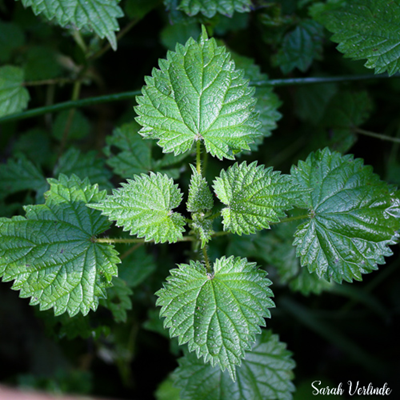Stinging nettle
Urtica dioica – Stinging nettle

Don’t touch this plant!
At a Glance:

- Family: Urticaceae
- Plant Type: spreading herbaceous plant
- Distribution: This subspecies is widely distributed through Washington and North America. There is another subspecies native to Europe (ssp. gracilis), and widespread throughout the world. We have both native and non-native species in the area.
- Habitat: moist forests and edges, partial to full shade
- Height: 3-9 feet tall
- Flower: small blooms along the stalk, dropping from where the leaves attach to the stem.
- Flowering Season: May – September
- Leaves: Deeply veined, narrowly heart shaped, and with a coarsely toothed margin, oppositely arranged. Stems are square shaped.
- Generation: Perennial
- Notable feature: contains stinging hairs, trichomes, that work like small needles injecting chemicals into the skin. It’s painful and will feel like a mosquito bite or burn on the skin.
Restoration and Conservation
Nettles are rarely planted for restoration applications, but contribute positively to the environment. Because of their harsh sting and quick growth they are often considered a weed. However, in partly shady and moist areas, they colonize well, cover the soil, and compete well with non-natives. Nettles grow well in high-nitrogen soils, and can be used for remediation of soils that have been over-fertilized or that have heavy metals in it (never harvest from these areas, the heavy metals are stored in the leaves). One stinging nettle plant can support over 40 species of insects.
Ethnobotany
The stems of the nettle plant have been an important source for fiber to make cording. Native American tribes would harvest the plant at the end of the growing season, and use the fibers for cord making to make fishing nets. Europeans have used nettle fiber for clothing production, which is similar to flax and linen. It’s dark leafy greens are high in vitamin C and iron and have been eaten plain or drank as tea for medicinal purposes.
References and Resources
- NCBI: https://www.ncbi.nlm.nih.gov/pmc/articles/PMC6100552
- NCI: https://blog.ncascades.org/naturalist-notes/two-burning-houses-a-natural-history-of-stinging-nettle
- WTU Image Herbarium: http://biology.burke.washington.edu/herbarium/imagecollection/taxon.php?Taxon=Urtica%20dioica
This article was written by Sarah Verlinde. For questions regarding the UWB/CC Plant Tour, contact Sarah at severlin@uw.edu.
